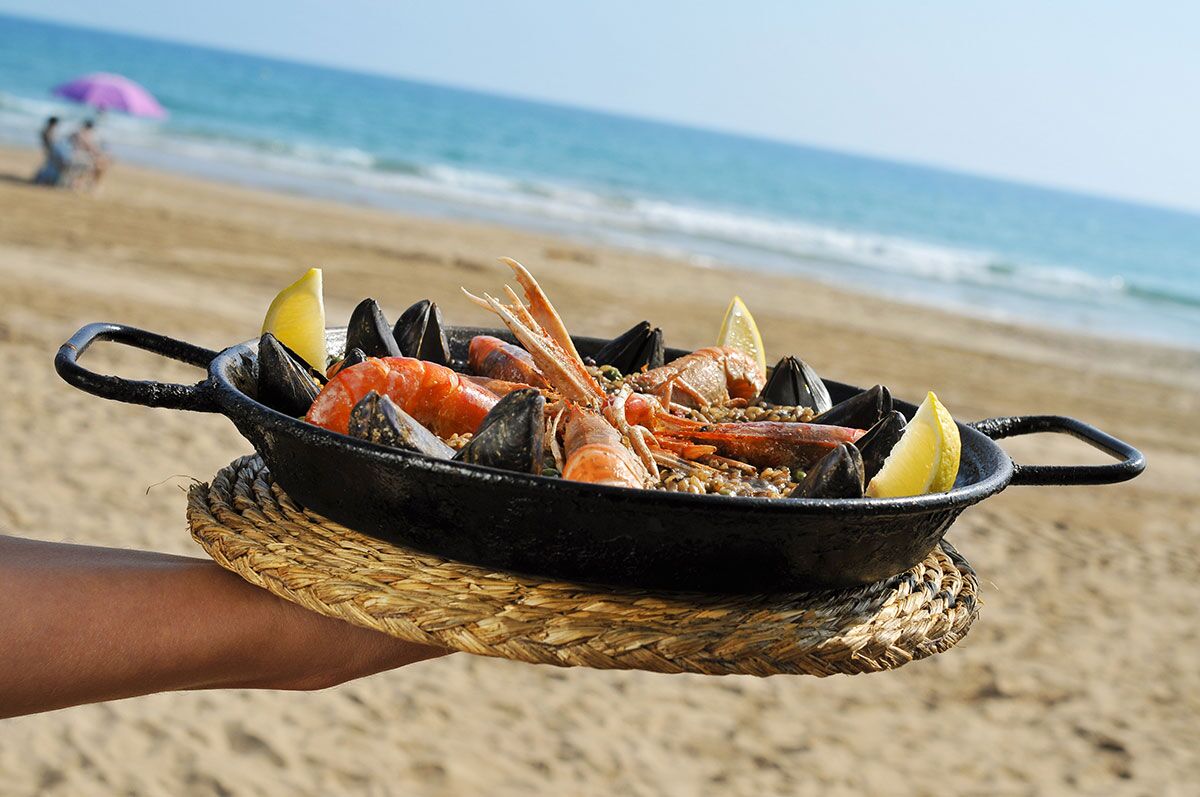Most people know that paella is a rice-based dish which contains vegetables, meat and/or fish, or a combination of these elements. It is also commonly known that saffron is used to give it that vibrant yellow shade it is so famous for. Some of the following information, however, may surprise you, as we unravel all there is to know about the famous Spanish national dish.
Article by Victoria Wood

First off, let’s make sure we know how to say it properly, as the Spanish would! Paella is phonetically spelled pah-EH-yah, whereby the central syllable is more pronounced.
A bit of history
Paella originated in the mid-19th century in the surrounding farms of Albufera lake near Valencia. Many Spanish consider paella to be a Valencian dish (the Valencians themselves identify with this) as opposed to the dish of the entire nation.
The original recipe (served as a lunch for the farmers and labourers in the surrounding rice fields) consists of round grain rice, bajoqueta and tavella (varieties of green beans), peas, rabbit, chicken, sometimes duck and garrofó (a variety of lima or butter bean) cooked in olive oil and chicken broth, it also often includes tomatoes, onions, and snails gathered from around the area. The dish is sometimes seasoned with whole rosemary branches.
Traditionally, the yellow colour comes from saffron as mentioned before, but turmeric and calendula can be used as substitutes. Artichoke hearts and stems may be used as seasonal ingredients – all of which were locally available at the time near the aforementioned lake (rice had become a staple farming crop at this time). The dish became seasonal, and subject to what was on offer from the surrounding land, hence the multiple variations.
Fun fact № 1
The Valencians say that the rice should be no deeper than ‘un ditet’ or a ‘little finger’ to encourage optimum flavour.
Ingredients that don’t vary in paella would be olive oil and rice. Which type of olive oil or rice of course can differ according to where you are, or the cook’s preference. The Valencians generally prefer to use Senia rice which is a little stickier than the Bomba rice that most of the Spanish tend to opt for. All would agree that good rice makes a good paella!
The name of the dish is not the actual food itself; it refers to and is derived from the wide, shallow pan that it is cooked in. It is a Valencian (Catalan) word that apparently comes from the Old French word ‘paelle’ for pan, or the Latin word ‘patella’, also meaning pan. A more modern French word for pan is ‘poêle’, in Italian it is ‘padella’, and in Old Spanish, ‘padilla’.
Fun fact № 2
March 27th is National Paella Day… In the United States… and no one really knows why.
The dish was originally cooked over an aromatic open fire stoked with pinecones, orange and pine branches giving it a distinct smokey flavour which infused into the dish (now often replaced with smoked paprika). The large wide pan allowed those present to feast directly out of the hot dish instigating its tradition for being a shared meal (it would be rare to find a paella-for-one on any menu in Spain).
Fun fact № 3
Paella should be eaten straight out of the pan. Any respectable restaurant that knows their paella, will serve it right in the pan it was cooked in. Paella is not a fancy dish, so there’s no need for a fancy presentation.
Although the Valencian version is considered to be the original and most beloved, there are many types of paella that have evolved over time. You can have ‘paella de marisco’ (seafood paella) which replaces meat with seafood and omits beans and green vegetables, while ‘paella mixta’ (mixed paella) combines meat from livestock, seafood, vegetables, and sometimes beans, with the traditional rice. There are many other local variations, but these are the standard types you are likely to find throughout the country.
Fun fact № 4
The Spanish would never consider eating paella for dinner – it is a lunch dish as it is too heavy to eat at night.
There are stages to cooking a paella, and each is as important as the next to achieve the right balance of textures and flavours. First the pan must be seasoned – greased lightly with olive oil. One of the first stages of the cooking is the ‘sofregit’ – the sauce. This is comprised of olive oil, onion and tomatoes and serves as the base of most paella dishes. This will vary wildly from household to household let alone restaurants or regions!
Fun fact № 5
The bottom layer of the rice, closest to the pan itself, is the most desired part of the dish. So much so that it even warranted being given a name of its own, the ‘socarrat’, to achieve this the lower layer of rice must have slightly toasted to the pan, not burnt, just lightly scrapeable off the paella pan at the end.
The main reason and purpose behind the paella is not just to satisfy hunger; from the greasing of the pan to the scraping of the ‘socarrat’ at the end, the entire process is one of community, inspired by sharing and bringing people together. As you can see, it is a fascinating dish steeped in history and so much more than just a bowl (or pan) of rice! Next time you order one, make sure it is with a group of close friends or family, grab a fork and get stuck in together – oh, and try not to fight over the crispy bit!
